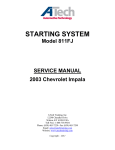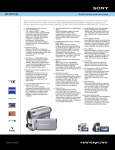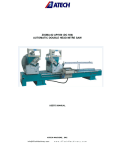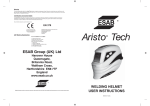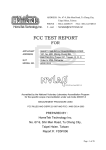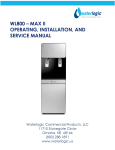Download 830Fj Wiper Washer service Manual Information
Transcript
MODEL 830FJ 2003 Chevrolet Impala Wiper/Washer Service Manual Information Table of Contents Wiper/Washer System Schematic…………………………………………………………1 Connector Pinout – Windshield Washer Fluid Level Switch……………………………..2 Connector Pinout – Windshield Washer Fluid Pump……….…………………………….3 Connector Pinout – Windshield Wiper System Module…….…………………………….4 Diagnostic Starting Point – Wiper/Washer Systems...………………………………...….5 Wiper/Washer System Description and Operation……………………………………...6-7 Symptoms - Wiper/Washer Systems ……..………………………………………………8 Wipers Inoperative - All Modes……………………………………………………….9-11 Wipers Inoperative - One or More Modes……………………………………………12-15 Wiper Blades Do Not Park…………………………………………………………...16-17 Washers Inoperative………………………………………………………………….18-19 Wiper Motor Crank Arm Replacement………………………………………………20-23 Wiper Drive System Module Replacement…………………………………………..24-26 Wiper Arm Replacement……………………………………………………………..27-28 Washer Solvent Container Replacement……………………………………………..29-32 Published by ATech Training, Inc. 12290 Chandler Drive Walton, KY 41094 USA Phone: (859) 485-7229 • Fax: (859) 485-7299 Email: [email protected] Website: www.atechtraining.com Copyright 2008, ATech Training, Inc. All Service Manual Information © General Motors Corporation. 1 Wiper/Washer Connector End Views Windshield Washer Fluid Level Switch Connector Part Information • 12162195 • 2-Way F Metri-Pack 150.2 Series Sealed P2S (BLK) Pin A B Circuit No. 150 99 Wire Color BLK BLK/WHT Function Ground Windshield Washer Fluid Level Signal 2 Windshield Washer Fluid Pump Connector Part Information Pin A B Wire Color RED BLK • 12052641 • 2-Way F Metri-Pack 150 Series, Sealed (BLK) Circuit No. 228 350 3 Function Windshield Washer Pump Control Ground Windshield Wiper System Module Connector Part Information • 12129126 • 5-Way F Metri-Pack Mixed 150, 280 Series Sealed (BLK) Pin A B C D E Circuit No. 115 343 92 113 112 Wire Color BLK YEL PPL DK GRN GRY Function Ground Accessory Voltage Windshield Wiper Motor High Speed Windshield Wiper Switch Signal 1 Windshield Wiper Switch Signal 2 4 Diagnostic Starting Point - Wiper/Washer Systems Begin the system diagnosis by reviewing the system Description and Operation. Reviewing the Description and Operation information will help you determine the correct symptom diagnostic p rocedure when a malfunction exists. Reviewing the Description and Operation information will also help you determine if the condition described by the customer is normal operation. Refer to Symptoms Wiper/Washer Systems in order to identify the correct procedure for diagnosing the system and where the procedure is located. 5 Wiper/Washer System Description and Operation Wiper/Washer System Components The Wiper/Washer System consists of the following components: z z z z z z Windshield wiper/washer switch Windshield wiper motor module Windshield wiper motor Windshield washer pump motor Windshield washer fluid level switch WSW 25A fuse Wiper/Washer System Operation The windshield wiper motor module is part of the windshield wiper motor cover and controls wiper motor operation. The windshield wiper motor is a 2 speed motor and is operated at low speed in all modes except HIGH. The accessory voltage supply circuit to the windshield wiper motor assembly is used to operate the wiper motor in all of the low speed modes. The accessory voltage supply circuit to the windshield wiper/washer switch is used to supply the windshield wiper switch signal circuits and the wiper motor high speed circuit. When the wiper/washer switch is in the LOW position voltage is supplied through a 24K ohm resistor within the switch to the windshield wiper switch signal 2 circuit, and accessory voltage is supplied to the windshield wiper switch signal 1 circuit. The reduced voltage from the wiper switch signal 2 circuit and accessory voltage from the wiper switch signal 1 circuit causes the wiper motor module to close the wiper motor accessory voltage supply circuit to the wiper motor low speed terminal. Windshield wiper/washer system MIST operation is identical to LOW operation except that the MIST switch is a press and release type. When the wiper switch is moved to the MIST position and released, low speed wiper motor operation is started and will continue until 1 cycle is complete. If the wiper switch is moved to the MIST position and held, the windshield wiper motor will operate in the LOW mode until the switch is released. Windshield wiper DELAY operation is a low speed wiper motor function with a variable delay interval between the wiper motor cycles. The DELAY interval is controlled through a series of resistors within the wiper/washer switch. During DELAY wiper operation the wiper switch signal 2 circuit is at the same voltage level used for LOW operation, but the wiper switch signal 1 circuit voltage is reduced through the DELAY resistors. The windshield wiper motor module uses a capacitor feed by the wiper switch signal 1 circuit to determine the frequency of the low speed wiper motor cycles. When the wiper switch signal 1 circuit is at the accessory voltage level as in the LOW switch position, the capacitor charges fast causing continuous low speed wiper motor operation. The DELAY switch position indicating the 6 longest interval between wiper motor cycles is the switch position with the highest resistance resulting in low voltage on the wiper switch signal 1 circuit. The low voltage charges the capacitor slowly causing a long delay interval between wiper motor cycles. As the DELAY switch is turned to positions indicating more frequent wiper cycles, the resistance through the wiper/washer switch is reduced and the wiper switch signal 1 circuit voltage increases. When the wiper switch signal 1 circuit voltage increases the capacitor charges faster and the delay interval between wiper motor cycles decreases. When the wiper/washer switch is in the HIGH position the accessory voltage to the wiper/washer switch is closed to the wiper motor high speed circuit. The accessory voltage on the high speed circuit is supplied to the wiper motor module and is used to operate the wiper motor at high speed. During HIGH speed wiper motor operation the wiper switch signal 1 and signal 2 circuits are at the LOW speed signal voltages, but the LOW speed signal circuit inputs to the wiper motor module have no effect on wiper motor high speed operation. The windshield wiper/washer system WASH function uses 2 switch contacts within the wiper/washer switch assembly. One switch contact closes the wiper/washer switch accessory voltage supply circuit to the wiper switch signal 2 circuit. Accessory voltage on the wiper switch signal 2 circuit causes the wiper motor module to close the wiper motor accessory voltage supply circuit to the wiper motor low speed terminal. The WASH command on the wiper switch signal 2 circuit will cause the wiper motor to operate at low speed for as long as the switch is held in the closed position and approximately 6 seconds after being released. The other WASH switch contact in the wiper/washer switch is the control circuit to the windshield washer pump. When the WASH switch is in the held in the closed position the wiper/washer switch accessory voltage supply circuit is used to operate the windshield washer pump until the switch is released. Windshield wiper motor park operation is controlled by the wiper motor module using an input from the park switch within the wiper motor assembly. When the windshield wiper/washer switch is turned to the OFF position while the wiper motor is somewhere in mid-cycle, the wiper motor module will continue to operate the wiper motor until the wipers reach the park position. Low Washer Fluid Indicator The low washer fluid indicator is controlled by the instrument panel cluster (IPC) using an input from the washer fluid level switch. The washer fluid level signal circuit is supplied ignition voltage through a resistor then monitored within the instrument cluster. The washer fluid level switch is normally open so the instrument cluster detects ignition voltage on the washer fluid level signal circuit whenever the washer fluid level is not low. When the washer fluid level reaches the point where the driver should be informed that the washer fluid is low, the washer fluid level switch closes. When the washer fluid level switch is closed the washer fluid level signal circuit voltage is pulled low, and the instrument cluster illuminates the LOW WASHER FLUID indicator. In order to prevent the LOW WASHER FLUID indicator from flashing due to sloshing in the washer fluid container, the instrument cluster is programed with a 1 minute delay before changing states of the LOW WASHER FLUID indicator during an ignition cycle. 7 Symptoms - Wiper/Washer Systems Important Review the system operation in order to familiarize yourself with the system functions. Refer to Wiper/Washer System Description and Operation . Visual/Physical Inspection z z z Inspect for aftermarket devices which could affect the operation of the Windshield Wiper/Washer System. Inspect the easily accessible or visible system components for obvious damage or conditions which could cause the symptom. Inspect the washer fluid reservoir for the proper fluid level. Intermittent Faulty electrical connections or wiring may be the cause of intermittent conditions. Refer to Testing for Intermittent and Poor Connections in Wiring Systems. Symptom List Refer to a symptom diagnostic procedure from the following list in order to diagnose the symptom: z z z z z z z Low Washer Fluid Indicator Malfunction Washers Always On Washers Inoperative Wipers Always On Wipers Inoperative - All Modes Wipers Inoperative - One or More Modes Wiper Blades Do Not Park 8 Wipers Inoperative - All Modes Step Action Schematic Reference: Wiper/Washer System Schematics Yes Connector End View Reference: Wiper/Washer System Connector End Views Did you review the Wiper/Washer System 1 description and operation and perform the necessary inspections? Go to Step 2 1. Turn ON the ignition ON, with the engine OFF. 2. Operate the windshield wiper/washer switch through all the switch 2 positions. Go to Testing for Intermittent and Poor Does the windshield wiper/washer system Connections in Wiring operate normally? Systems 1. Turn OFF the ignition. 2. Disconnect the harness connector of the windshield wiper motor. 3. Turn the ignition ON, with the engine OFF. 4. Connect a test lamp from the 3 accessory voltage circuit of the windshield wiper motor to a good ground. 4 5 No Go to Symptoms Wiper/Washer Systems Go to Step 3 Does the test lamp illuminate? Connect a test lamp from the accessory voltage circuit to the ground circuit of the windshield wiper motor. Go to Step 4 Go to Step 12 Does the test lamp illuminate? 1. Connect a test lamp from the signal 2 circuit of the windshield wiper switch to a good ground. 2. Press the windshield washer switch. Go to Step 5 Go to Step 13 Does the test lamp illuminate? Go to Step 10 Go to Step 6 9 6 1. Turn OFF the ignition. 2. Disconnect the harness connector of the windshield wiper/washer switch. 3. Turn ON the ignition, with the engine OFF. 4. Connect a test lamp from the accessory voltage circuit of the windshield wiper/washer switch to a good ground. Does the test lamp illuminate? Test the accessory voltage circuit of the windshield wiper/washer switch for an open or short to ground. Refer to Circuit Testing or Wiring Repairs in 7 Wiring Systems. 8 9 Did you find and correct the condition? Test the signal 2 circuit of the windshield wiper/washer switch for a short to ground. Refer to Circuit Testing or Wiring Repairs in Wiring Systems. Did you find and correct the condition? Test the high speed circuit of the windshield wiper/washer switch for a short to ground. Refer to Circuit Testing or Wiring Repairs in Wiring Systems. Did you find and correct the condition? Inspect for poor connections at the windshield wiper motor. Refer to Testing for Intermittent and Poor Connections and Connector Repairs in Wiring 10 Systems. Did you find and correct the condition? Inspect for poor connections at the windshield wiper/washer switch. Refer to Testing for Intermittent and Poor Connections and to Connector Repairs in 11 Wiring Systems. Did you find and correct the condition? Repair an open or a short to ground in the accessory voltage circuit of the windshield wiper motor. Refer to Wiring Repairs or Connector Repairs in 12 Wiring Systems. Did you complete the repair? Repair an open or high resistance in the ground circuit of the windshield wiper motor. Refer to Wiring Repairs or Connector Repairs in Wiring 13 Systems. Go to Step 11 Go to Step 7 Go to Step 17 Go to Step 8 Go to Step 17 Go to Step 9 Go to Step 17 Go to Step 14 Go to Step 17 Go to Step 15 Go to Step 17 Go to Step 16 Go to Step 17 -- Go to Step 17 Did you complete the repair? Repair a short to ground in the control circuit of the windshield washer pump. Refer to Wiring Repairs or Connector Repairs in Wiring Systems. 14 Go to Step 17 Did you complete the repair? 10 -- -- Replace the windshield wiper motor. Refer to Wiper Motor Replacement . 15 16 Did you complete the replacement? Replace the windshield wiper/washer switch. Refer to Multifunction, Turn Signal Switch Replacement in Steering Wheel and Column. Did you complete the replacement? Operate the system in order to verify the repair. 17 Did you correct the condition? 11 Go to Step 17 -- Go to Step 17 -- System OK Go to Step 3 Wipers Inoperative - One or More Modes Test Description The numbers below refer to the step numbers on the diagnostic table. 8. This step tests for continuity through the 24K ohms resistor in the windshield wiper/washer switch. The connector behind the instrument panel knee bolster is suitable for performing this step. 9. This step tests for continuity through the delay resistors in the windshield wiper/washer switch. The measured resistance will change in sequence from high to low as the delay speed is increased. The connector behind the instrument panel knee bolster is suitable for performing this step. Value Step Action (s) Schematic Reference: Wiper/Washer System Schematics Yes No Connector End View Reference: Wiper/Washer System Connector End Views Did you review the Wiper/Washer Go to Symptoms 1 System Description and Operation and -Wiper/Washer perform the necessary inspections? Systems Go to Step 2 1. Turn the ignition ON. 2. Operate the windshield wiper/washer switch through all the switch positions. 2 -Go to Testing for Intermittent Conditions and Does the windshield wiper/washer Poor Connections in Go to Step 3 system operate normally? Wiring Systems Do the windshield wipers operate in 3 -Go to Step 5 Go to Step 4 the high speed mode? 1. Disconnect the windshield wiper motor connector. 2. Connect a test lamp from the windshield wiper motor high speed circuit terminal to ground. 3. Turn the ignition ON. 4 -4. Operate the windshield wiper/washer switch to the high speed position. Does the test lamp illuminate? Go to Step 16 12 Go to Step 10 5 1. Disconnect the windshield wiper motor connector. 2. Connect a test lamp from the windshield wiper motor accessory voltage supply circuit terminal to ground. 3. Turn the ignition ON. Does the test lamp illuminate? 1. Connect a test lamp from the windshield wiper switch signal 2 circuit terminal to ground. 6 2. Press the windshield washer switch. 7 8 Does the test lamp illuminate? 1. Connect a test lamp from the windshield wiper switch signal 1 circuit terminal to ground. 2. Operate the windshield wiper/washer switch to the following positions: - MIST - LO - HI Does the test lamp illuminate in the listed switch positions? 1. Disconnect the windshield wiper/washer switch connector. 2. Measure the resistance through the windshield wiper/washer switch from the signal 2 circuit terminal to the accessory voltage supply circuit terminal in the switch side connector. 3. Operate the windshield wiper/washer switch to the following positions: - MIST - INT - LO - HI Is the resistance at or near the specified value in all the listed switch positions? 13 -Go to Step 6 Go to Step 11 Go to Step 7 Go to Step 12 Go to Step 8 Go to Step 13 -- -- 24K ohms 9 1. Measure the resistance through the windshield wiper/washer switch from the signal 1 circuit terminal to the accessory voltage supply circuit terminal in the switch side connector. 2. Operate the windshield wiper/washer switch through all of the delay positions. Does the resistance remain within the specified values from high to low as the delay speed is increased? Test the windshield wiper motor high speed circuit for an open or high resistance. Refer to Circuit Testing and Wiring Repairs in 10 Wiring Systems. Did you find and correct the condition? Repair the windshield wiper motor accessory voltage supply circuit for an open or high resistance. Refer to Wiring Repairs in Wiring 11 Systems. Is the repair complete? Test the windshield wiper switch signal 2 circuit for an open or short to ground. Refer to Circuit Testing and Wiring Repairs in Wiring 12 Systems. Did you find and correct the condition? Test the windshield wiper switch signal 1 circuit for an open or short to ground. Refer to Circuit Testing and Wiring Repairs in Wiring 13 Systems. Did you find and correct the condition? Inspect for poor connections at the windshield wiper/washer switch. Refer to Testing for Intermittent Conditions and Poor Connections 14 and Connector Repairs in Wiring Systems. Did you find and correct the condition? Replace the windshield wiper/washer switch. Refer to Multifunction, Turn Signal Switch Replacement in Steering Wheel 15 and Column. Is the repair complete? Inspect for poor connections at the windshield wiper motor. Refer to Testing for Intermittent Conditions and Poor Connections and 16 Connector Repairs in Wiring Systems. Did you find and correct the condition? 14 38K 690K ohms Go to Step 16 Go to Step 14 Go to Step 18 Go to Step 14 Go to Step 18 -- Go to Step 18 Go to Step 14 Go to Step 18 Go to Step 14 Go to Step 18 Go to Step 15 Go to Step 18 -- Go to Step 18 Go to Step 17 -- -- -- -- -- -- -- 17 Replace the windshield wiper motor module. Refer to Wiper Motor Cover Replacement . Is the repair complete? Operate the system in order to verify the repair. 18 Did you correct the condition? 15 - Go to Step 18 -- System OK Go to Step 3 Wiper Blades Do Not Park Step Action Schematic Reference: Wiper/Washer System Schematics Yes No Connector End View Reference: Wiper/Washer System Connector End Views DEFINITION: This table diagnoses the wipers operate normally but will not return to the park position when the wiper operation is cancelled. Did you review the Wiper/Washer System Go to Diagnostic 1 Description and Operation and perform Starting Point the necessary inspections? Go to Step 2 Wiper/Washer Systems 1. Turn ON the ignition, with the engine OFF. 2. Move the wiper switch to the LO position. 3. Move the wiper switch to the OFF 2 position. Go to Testing for Intermittent and Poor Connections in Wiring Do the front wipers advance to the park Systems Go to Step 3 position? 1. Turn the ignition switch to the RUN position. 2. Turn the wiper switch to OFF. 3. Disconnect the wiper/washer switch 3 connector. 4 Do the wipers park? At the wiper/washer switch connector, measure the voltage of the windshield wiper switch signal 2 circuit. Does the voltage measure greater than 1.0 volts? 16 Go to Step 7 Go to Step 4 Go to Step 5 Go to Step 8 5 6 7 1. Reconnect the wiper/washer switch connector. 2. Disconnect the wiper motor connector. 3. Measure the voltage of the windshield wiper switch signal 2 circuit. Does the voltage measure greater than 1.0 volts? Repair a short to battery positive voltage in the windshield wiper switch signal 2 circuit. Refer to Circuit Testing and Wiring Repairs in Wiring Systems. Did you find and correct the condition? Replace the wiper/washer switch. Refer to Multifunction, Turn Signal Switch Replacement in Steering Wheel and Column - Tilt. Did you complete the replacement? Replace the wiper motor cover. Refer to Wiper Motor Cover Replacement. 8 Did you complete the replacement? Operate the system in order to verify the repair. 9 Go to Step 6 Go to Step 8 Go to Step 9 -- Go to Step 9 -- Go to Step 9 -- System OK Did you correct the condition? 17 Go to Step 2 Washers Inoperative Step Action Schematic Reference: Wiper/Washer System Schematics Yes Connector End View Reference: Wiper/Washer System Connector End Views Did you review the Wiper/Washer System 1 Description and Operation and perform the necessary inspections? Go to Step 2 1. Turn the ignition ON. Go to Testing for 2. Press the windshield washer switch. Intermittent and Poor 2 Connections in Wiring Do the windshield washers operate normally? Systems 1. Disconnect the windshield washer pump connector. 2. Connect a test lamp across the washer pump harness connector terminals. 3 3. Turn the ignition ON. 4. Press the windshield washer switch. No Go to Symptoms Wiper/Washer Systems Go to Step 3 Go to Step 8 Go to Step 4 4 Does the test lamp illuminate? Test the windshield washer pump ground circuit for an open or high resistance. Refer to Circuit Testing and Wiring Repairs in Wiring Systems. Go to Step 10 Go to Step 5 5 Did you find and correct the condition? Test the windshield washer pump control circuit for an open or high resistance. Refer to Circuit Testing and Wiring Repairs in Wiring Systems. Did you find and correct the condition? Inspect for poor connections at the windshield wiper/washer switch. Refer to Testing for Intermittent and Poor Connections and Connector Repairs in Wiring Systems. Go to Step 10 Go to Step 6 Did you find and correct the condition? Go to Step 10 Go to Step 7 6 18 7 Replace the windshield wiper/washer switch. Refer to Multifunction, Turn Signal Switch Replacement in Steering Wheel and Column. Is the repair complete? Inspect for poor connections at the windshield washer pump. Refer to Testing for Intermittent and Poor Connections and Connector Repairs in Wiring 8 Systems. Did you find and correct the condition? Replace the windshield washer pump. Refer to Washer Pump Replacement . 9 Is the repair complete? Operate the system in order to verify the repair. 10 Did you correct the condition? 19 Go to Step 10 -- Go to Step 10 Go to Step 9 Go to Step 10 -- System OK Go to Step 3 Wiper Motor Crank Arm Replacement Tools Required • J 39232 Wiper Transmission Separator • J 39529 Wiper Transmission Installer Removal Procedure 1. Remove the air inlet grille panel. Refer to Air Inlet Grille Panel Replacement in Body Front End. 2. Remove the wiper motor water deflector. Refer to Wiper Motor Water Deflector Replacement. 3. Using the J 39232, disconnect the wiper transmission from the wiper motor crank arm. 20 4. Remove the wiper motor crank arm cover. 5. Remove the wiper motor crank arm screw. 6. Remove the wiper motor crank arm from the wiper motor. Installation Procedure 1. Before installing the wiper motor crank arm, the wiper motor must be in the inner wipe position of the delay mode. 2. Position the wiper motor crank arm onto the wiper motor. 3. Measure the gap between wiper motor crank arm and the bracket tab. If the gap is not 4-8 mm (0.157-0.314 in), remove the wiper motor crank arm and repeat installation. 21 Notice: Refer to Fastener Notice in Cautions and Notices. 4. Install the wiper motor crank arm screw . Tighten Tighten the screw to 16 N·m (12 lb ft). 5. Install the wiper motor crank arm cover. 6. Using the J 39529 , install the wiper transmission to the wiper motor crank arm. 7. Install the air inlet grille panel. Refer to Air Inlet Grille Panel Replacement in Body Front End. 8. Install the wiper motor water deflector. Refer to Wiper Motor Water Deflector Replacement. 22 9. Operate the windshield wipers and inspect for proper operation. 23 Wiper Drive System Module Replacement Tools Required • J 39232 Wiper Transmission Separator • J 39529 Wiper Transmission Installer Removal Procedure 1. Remove the air inlet grille panel. Refer to Air Inlet Grille Panel Replacement in Body Front End. 2. Remove the wiper motor water deflector. Refer to Wiper Motor Water Deflector Replacement. 3. Using the J 39232 , disconnect the wiper transmission from the wiper motor crank arm to aid in the removal of the wiper drive system module. 24 4. Remove the wiper drive system module screws. 5. Disconnect the wiper motor electrical connector. 6. Remove the wiper drive system module from the vehicle. Installation Procedure 1. Position the wiper drive system module to the vehicle. 2. Connect the wiper motor electrical connector. Notice: Use the correct fastener in the correct location. Replacement fasteners must be the correct part number for that application. Fasteners requiring replacement or fasteners requiring the use of 25 thread locking compound or sealant are identified in the service procedure. Do not use paints, lubricants, or corrosion inhibitors on fasteners or fastener joint surfaces unless specified. These coatings affect fastener torque and joint clamping force and may damage the fastener. Use the correct tightening sequence and specifications when installing fasteners in order to avoid damage to parts and systems. 3. Install the wiper drive system screws. Tighten Tighten the screws to 10 N·m (89 lb in). 4. 5. 6. 7. Using the J 39529 , Install the wiper transmission to the wiper motor crank arm. Install the wiper motor water deflector. Refer to Wiper Motor Water Deflector Replacement . Install the air inlet grille panel. Refer to Air Inlet Grille Panel Replacement in Body Front End. Inspect the wipers for proper operation. 26 Wiper Arm Replacement Tools Required J 39822 Wiper Arm Puller Removal Procedure 1. 2. 3. 4. 5. 6. 7. Turn the ignition ON. Turn the wiper switch to DELAY. Turn the ignition OFF when the wiper arms are paused at the bottom of the wipe pattern. Disconnect the washer hose from the wiper arm. Remove the wiper arm nut cover. Remove the wiper arm nut. Using the J 39822, remove the wiper arm from the wiper transmission. 27 Installation Procedure 1. Install the wiper arms onto the wiper transmission. 2. Hold the measuring device at a 90 degree angle to the wiper blade while maintaining the following distances: - Right arm: 97-107 mm (3.82-4.21 in) from the end of the wiper arm to the air inlet screen - Left arm: 125-147 mm (4.92-5.78 in) from the wiper blade tip to the air inlet screen 3. Apply Threadlocking compound, GM P/N 89021297 (Canadian P/N 10953488) or equivalent, to the wiper arm nut. Notice: Refer to Fastener Notice in Cautions and Notices. 4. Install the wiper arm nut. Tighten Tighten the nut to 30 N·m (22 lb ft). 5. Install the wiper arm nut cover. 6. Connect the washer hose to the wiper arm. 7. Operate the windshield wipers and inspect for proper operation. 28 Washer Solvent Container Replacement Removal Procedure 1. Drain the washer solvent from the washer solvent container. 2. Remove the washer solvent container filler neck. Refer to Washer Solvent Container Filler Neck Replacement. 3. Remove the right headlamp assembly. Refer to Headlamp Assembly or Headlamp Bulb and/or Cornering, Sidemarker, Park, Turn Signal Bulb Replacement in Lighting Systems. 4. Remove the washer solvent container screws. 5. Remove the front fender liner. Refer to Front Fender Liner Replacement in Body Front End. 29 6. Disconnect the washer pump hose. 7. Disconnect the washer pump electrical connector. 8. Disconnect the washer solvent level sensor electrical connector. 9. Remove the washer solvent container bracket screw. 10. Remove the washer solvent container from the right frame rail. Installation Procedure 30 1. Position the washer solvent container to the right frame rail. Notice: Refer to Fastener Notice in Cautions and Notices. 2. Install the washer solvent container bracket screw. Tighten Tighten the screw to 10 N·m (89 lb in). 3. Connect the washer solvent level sensor electrical connector. 4. Connect the washer pump electrical connector. 31 5. Connect the washer pump hose. 6. Install the front fender liner. Refer to Front Fender Liner Replacement in Body Front End. 7. Install the washer solvent container screws. Tighten Tighten the screws to 10 N·m (89 lb in). 8. Install the right headlamp assembly. Refer to Headlamp Assembly or Headlamp Bulb and/or Cornering, Sidemarker, Park, Turn Signal Bulb Replacement in Lighting Systems. 9. Install the washer solvent container filler neck. Refer to Washer Solvent Container Filler Neck Replacement . 10. Fill the washer solvent container with washer solvent. 32




































